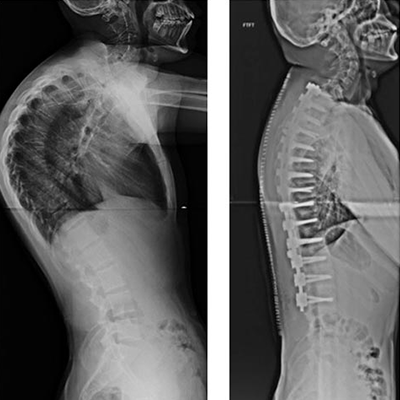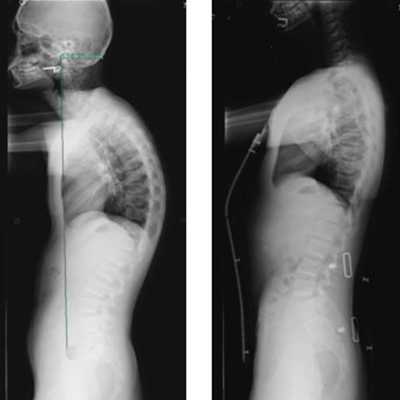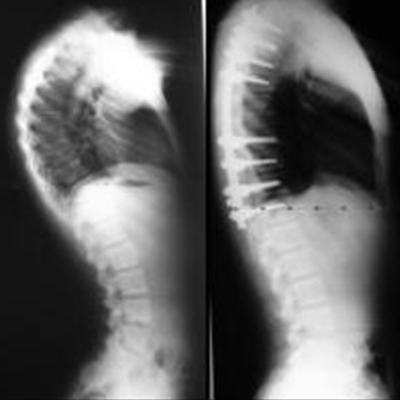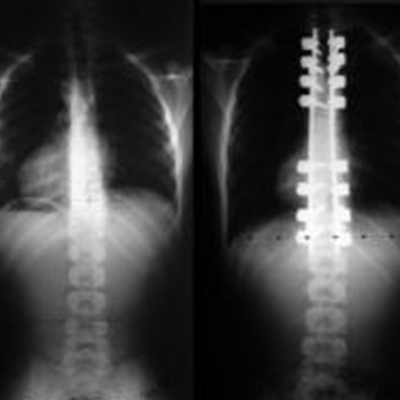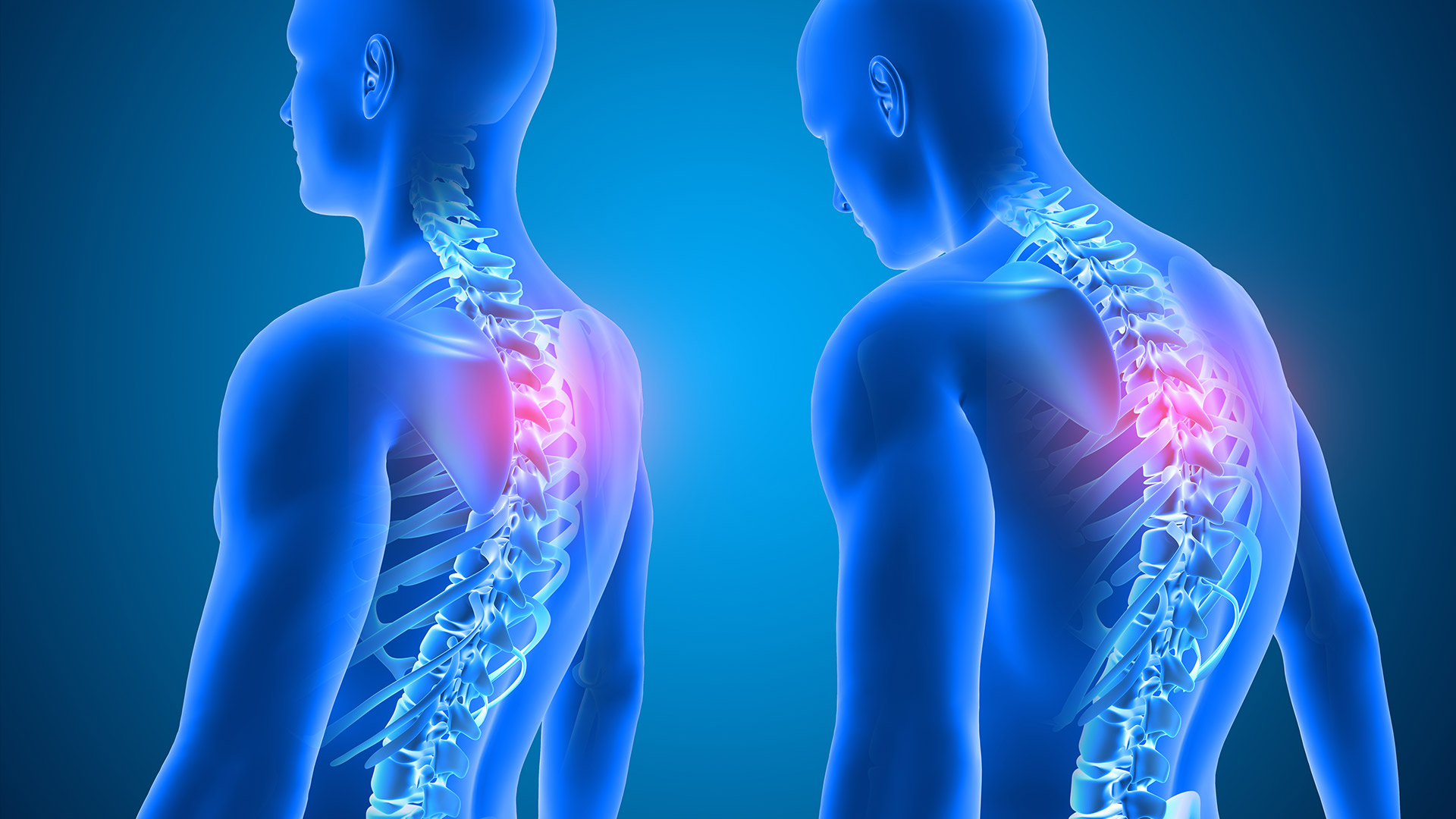
Kyphosis
When we look at the spine from the back, we see a straight column that is formed by the arrangement of vertebrae on top of each other and passes through the exact center of the head and pelvis. However, when we look at the human spine from the side, we see that there is no such straight line and that there are physiological curvatures formed by each vertebra making an angle with each other. For example, while we have a kyphosis (hump) in our chest and back region, we have a hollow in our following waist region.
The degree of kyphosis in the chest and back region varies widely among individuals. In other words, as you observe around you, some people have a more hunched posture while others stand more upright. There is a quantifiable physiological limit to this hump.
In a lateral radiograph taken in a comfortable standing position, this limit varies between 20 degrees and 55 degrees when measured at an angle. In other words, a person with a kyphosis of 20 degrees and a person with a kyphosis of 55 degrees are both considered within the normal limits of kyphosis. Therefore, it is perfectly normal for one member of a family to be more or less hunched than another.
WHAT CAN BE DONE TO PREVENT KYPHOSIS?
Exercises aimed at preventing kyphosis are generally related to poor posture. It is necessary to stretch the short abdominal, chest, and leg muscles, as well as to strengthen the muscles around the spine. In cases where the inclination is too high, surgical treatment should be applied. While the hump is corrected by the surgical operation, the progression of the curvature can also be prevented.
Especially in women, serious back pain and hunching can cause difficulty in breathing as well as psychological problems.
Initially, this hump is thought to be related to posture, but over time, it can progress and become permanent.
In cases where back pain persists and hunching is significant for a long time, it is essential to have a kyphosis measurement and to be monitored by a physician.
In addition, there are certain simple measures that can be taken for back pain and hunching due to sedentary lifestyle. Strengthening exercises for the back and abdominal muscles, as well as swimming, are particularly important.
ABOUT KYPHOSIS
What is Postural (due to poor posture) or positional kyphosis?
The positional kyphosis, for instance, increasing the kyphosis of a person with a physiological standing posture of 35 degrees to 55 degrees due to poor posture is a form of postural kyphosis. This is the most common cause of the hunchback complaint that parents observe in their children.
What is structural kyphosis or Schuermann kyphosis?
Structural kyphosis is a hump that is often due to an underlying bone or soft tissue pathology and is above 55 degrees even in a person’s physiological standing position. This kyphosis may be due to congenital spinal anomalies (congenital kyphosis), some bone diseases (skeletal dysplasia, neurofibromatosis, etc.), spinal infections (spinal tuberculosis, etc.), or various nerve and muscle diseases caused by damage to the vertebrae due to spinal fractures.
However, the most common cause of structural kyphosis in growing patients is the kyphosis called Schuermann’s disease, which is caused by an unknown influence and leads to the loss of rectangular shapes of the vertebrae and triangularization of them. If Schuermann’s disease is not treated, it can result in the increase of kyphosis to dangerous levels.”
They can be distinguished from each other with a test that families can easily do. If your child can significantly straighten their current hump when you tell them to stand up straight, it is most likely postural kyphosis. The important thing to note here is where the hump is straightening from.
If the hump is straightening from its most prominent point, then there is no problem. Sometimes the most prominent point of the hump does not straighten at all, and there may be a slight correction in the upper or lower vertebrae. Sometimes the kyphosis may show only a slight improvement, rather than a significant one. In these two cases, it may be necessary to consult your doctor and seek professional help.
The most important causes of postural kyphosis are poor sitting posture and physical fitness deficiency. Especially nowadays, children spend most of their time in the triangle of school, tutoring, and computer. Unfortunately, children stay away from games or sports activities that make them move. This lifestyle not only causes our children to spend most of their time in a bad sitting position but also causes them to have a poor physical condition due to their inability to exercise. These two bad habits are the most important causes of postural kyphosis.
We would like to remind you that heavy school bags, which are generally blamed for this issue, are not the real culprit. However, heavy school bags are not suitable for spinal health. In childhood, they can lead to back and waist pain, and in later years, they can cause conditions such as lower back pain and herniated disc.
In fact, what parents most often do in this issue is to constantly remind their children to “stand up straight”. The child usually stands up straight when reminded, but then returns to the hunched position afterwards. Then a second, then a third reminder comes, but the reminders do not work at all and sometimes cause serious tension and stubbornness between the parents and the child.
Our advice to parents is to stop these kinds of repeated reminders. To prevent postural kyphosis, the causes must be eliminated first. It is not realistic to make today’s children give up school, tutoring, and computer activities.
There are some things we can control about this issue. Starting with sitting habits is the first step. A good start would be to ensure that children’s desks and chairs are at the appropriate position, angle and height, and to adjust the monitor and keyboard heights to the appropriate positions. With these adjustments, we can ensure that our children get used to the ideal position where they can keep their spine within physiological limits.
Another important issue is to convince and motivate our children to spend time for sports. Sports will prevent postural hunchback by increasing your child’s physical condition, strength and endurance of the muscles that keep the spine upright. The best proof of this is that we complain less about your child’s hunchback in the summer months when he/she is more active in sports. One hour of sportive activity at least 3 days a week will help to solve the problem of poor posture.
Just like scoliosis, whose cause is unknown, it is not fully understood what causes Schuermann’s disease. When we look at the structure of the spine, it is characterized by prominent wedging in 1 to 3 consecutive vertebrae at the center of the hump and structural abnormalities in the discs between the vertebrae. There is no proven relationship between Schuermann kyphosis and carrying heavy loads or constantly standing in a hunched position.
Schuermann kyphosis is generally seen between the ages of 8 and 12. It is believed to occur equally in girls and boys. Usually, the curvature is seen in two types. In the first and most common type, the curvature is in the thoracic region. In the other type, the curvature is prominent in the junction of the thoracic and lumbar regions. Additionally, patients may experience back and waist pain together. In some patients, mild scoliosis (lateral curvature of the spine) may accompany kyphosis.
Corset treatment
Bracing may be appropriate for moderate Schuermann’s kyphosis. There are many braces used for this treatment. They are all designed to prevent the curve from increasing as the child grows. The brace acts as a counter support to prevent the curve from increasing during active skeletal growth. Corsets do not completely straighten the spine and do not prevent the kyphosis from increasing in at least half of the patients. The best expected success of the brace is to prevent the kyphosis from progressing further and reaching the surgical margin.
What is required for successful bracement treatment?
- – Early diagnosis made while the patient is still growing (curvature detected before menstrual periods in girls)
- – Mild to moderate Schuermann kyphosis (between 60-75 degrees)
- – Regular check-ups by a spine specialist
- – A properly fitted brace for the patient
- – A compliant patient and supportive family
- – Continuing normal activities including exercise, dance training, and athletics, with intermittent brace removal during these activities under doctor supervision
- – Wearing the brace for at least 20-23 hours a day.
WHEN IS SURGICAL TREATMENT NECESSARY FOR SCHUERMANN KYPHOSIS?
There is no consensus on the degree of curvature that requires surgical treatment for Schuermann kyphosis. However, there is a general agreement that curvatures above 75 degrees definitely require surgery. The most commonly preferred method for this deformity is posterior instrumentation and fusion, as in scoliosis.
In cases of severe curvature, corrections made by removing pieces of spinal bone, which we call osteotomy, can also be added. Patients are mobilized on the day after surgery and are discharged within approximately 5-7 days. In some cases, a short-term (3 months) brace may be applied when discharged. Children can return to school within approximately 3 weeks. After three months, they can engage in exercises such as walking and swimming, and Cycling is allowed after 6 months. Sports that involve physical contact, such as football and basketball, are prohibited until the end of the first year. By the end of the first year, they are allowed to return to their normal activities.


